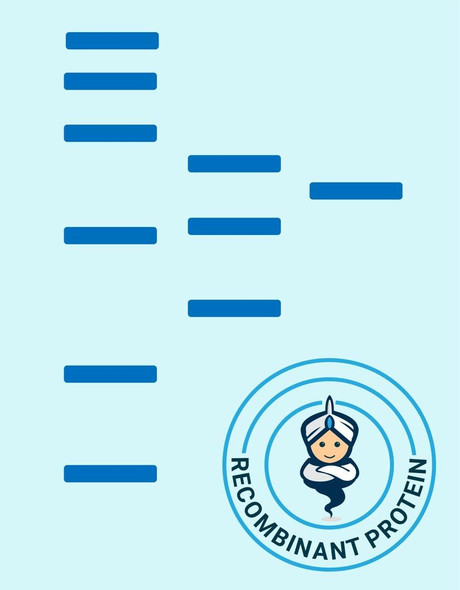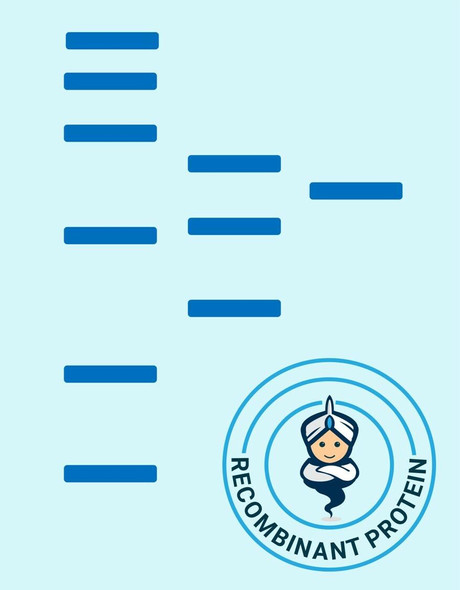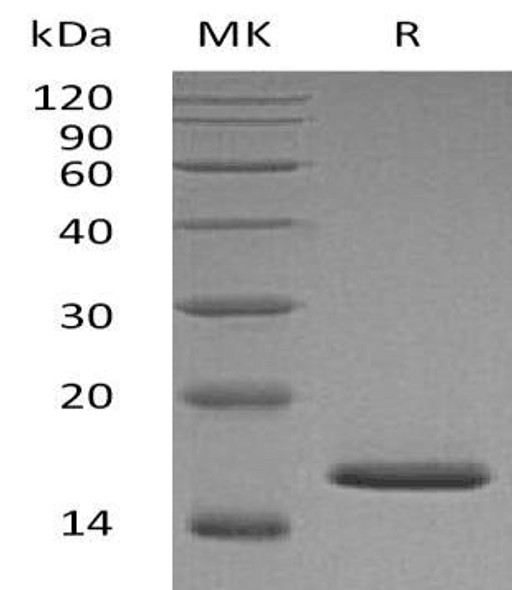Growth Factors & Cytokines Recombinant Proteins
Mouse FGF 21 Recombinant Protein (RPPB0244)
- SKU:
- RPPB0244
- Product Type:
- Recombinant Protein
- Species:
- Mouse
- Uniprot:
- Q9JJN1
- Research Area:
- Growth Factors & Cytokines
Description
| Product Name: | Mouse FGF 21 Recombinant Protein |
| Product Code: | RPPB0244 |
| Size: | 10µg |
| Species: | Mouse |
| Target: | FGF 21 |
| Synonyms: | Fibroblast growth factor 21, FGF-21. |
| Source: | Escherichia Coli |
| Physical Appearance: | Filtered white lyophilized powder. |
| Formulation: | Filtered (0.4 �m) and lyophilized from 0.5 mg/ml in 20mM TRIS, 20mM NaCl, pH 7.5. |
| Solubility: | It is recommended to add deionized water to prepare a working stock solution of approximately 0.5 mg/ml and let the lyophilized pellet dissolve completely. Product is not sterile! Please filter the product by an appropriate sterile filter before using it in the cell culture. Add DTT (0.2mM) and NaCl (0.1-0.15M) before freezing to prevent potential aggregation. |
| Stability: | Lyophilized FGF-21 Mouse Recombinant although stable at room temperature for 3 weeks, should be stored desiccated below -18°C. Upon reconstitution Fibroblast Growth Factor 21 should be stored at 4°C between 2-7 days and for future use below -18°C. For long term storage it is recommended to add a carrier protein (0.1% HSA or BSA).Please prevent freeze-thaw cycles. |
| Purity: | Greater than 95.0% as determined by:(a) Analysis by RP-HPLC.(b) Analysis by SDS-PAGE. |
| Amino Acid Sequence: | MKHHHHHHAS AYPIPDSSPL LQFGGQVRQR YLYTDDDQDT EAHLEIREDG TVVGAAHRSP ESLLELKALKPGVIQILGVK ASRFLCQQPD GALYGSPHFD PEACSFRELL LEDGYNVYQS EAHGLPLRLP QKDSPNQDATSWGPVRFLPM PGLLHEPQDQ AGFLPPEPPD VGSSDPLSMV EPLQGRSPSY AS |
The FGFs are a family of more than 20 small (~17�26 kDa) secreted peptides. The initial characterization of these proteins focused on their ability to stimulate fibroblast proliferation. This mitogenic activity was mediated through FGF receptors (FGFRs) 1, 2, or 3. A fourth closely related tyrosine kinase receptor (FGFR4) was able to bind the FGFs but did not lead to a mitogenic response.FGFs modulate cellular activity via at least 5 distinct subfamilies of high-affinity FGF receptors (FGFRs): FGFR-1, -2, -3, and -4, all with intrinsic tyrosine kinase activity and, except for FGFR-4, multiple splice isoforms, and FGFR-5, which lacks an intracellular kinase domain. There is growing evidence that FGFRs can be important for regulation of glucose and lipid homeostasis. The overexpression of a dominant negative form of FGFR-1 in cells leads to diabetes in mice, which thus implies that proper FGF signaling is required for normal cell function and glycemia maintenance. FGFR-2 appears to be a key molecule during pancreatic development. Moreover, FGFR-4 has been implicated in cholesterol metabolism and bile acid synthesis.FGF-19, has been shown to cause resistance to diet-induced obesity and insulin desensitization and to improve insulin, glucose, and lipid profiles in diabetic rodents. Since these effects, at least in part, are mediated through the observed changes in metabolic rates, FGF-19 can be considered as a regulator of energy expenditure.FGF-21 is preferentially expressed in liver, but an exact knowledge of FGF-21 bioactivity and its mode of action have been lacking to date. FGF-21 is a potent activator of glucose uptake on adipocytes, protects animals from diet-induced obesity when overexpressed in transgenic mice, and lowers blood glucose and triglyceride levels when therapeutically administered to diabetic rodents.
Fibroblast Growth Factor -21 Mouse Recombinant produced in E.Coli is a single, non-glycosylated, polypeptide chain containing 192 amino acids and having a molecular mass of 21.2 kDa. The amino acid sequence of the recombinant human FGF21 is 100% homologous to the amino acid sequence of the Mouse FGF21 without signal sequence and contains 10 a.a. His tag at N-terminal.The FGF-21 is purified by proprietary chromatographic techniques.
| UniProt Protein Function: | FGF21: Stimulates glucose uptake in differentiated adipocytes via the induction of glucose transporter SLC2A1/GLUT1 expression (but not SLC2A4/GLUT4 expression). Activity requires the presence of KLB. Belongs to the heparin-binding growth factors family. |
| UniProt Protein Details: | Protein type:Secreted, signal peptide; Secreted Cellular Component: extracellular region; extracellular space Molecular Function:fibroblast growth factor receptor binding; growth factor activity; receptor binding Biological Process: fibroblast growth factor receptor signaling pathway; positive regulation of cell proliferation; positive regulation of glucose import |
| UniProt Code: | Q9JJN1 |
| NCBI GenInfo Identifier: | 13626695 |
| NCBI Gene ID: | 105242481 |
| NCBI Accession: | Q9JJN1.1 |
| Molecular Weight: | 23,237 Da |
| NCBI Full Name: | Fibroblast growth factor 21 |
| NCBI Official Symbol: | LOC105242481�� |
| NCBI Protein Information: | fibroblast growth factor 21 |
| UniProt Protein Name: | Fibroblast growth factor 21 |
| Protein Family: | Fibroblast growth factor |
| UniProt Gene Name: | Fgf21�� |
| UniProt Entry Name: | FGF21_MOUSE |






